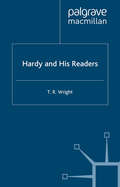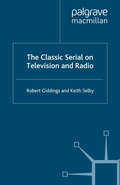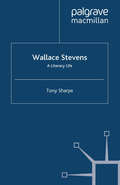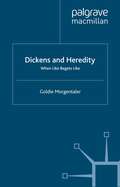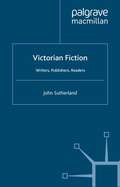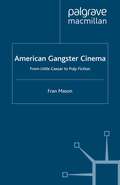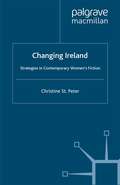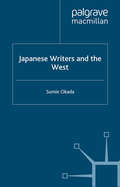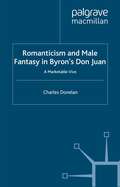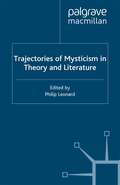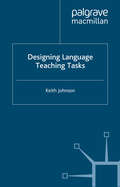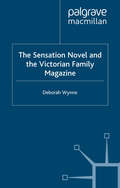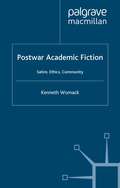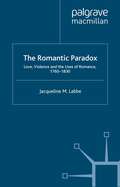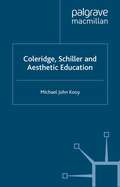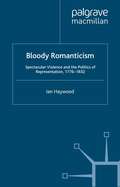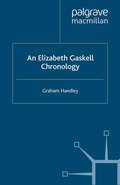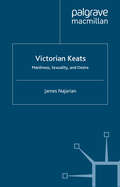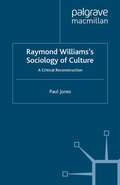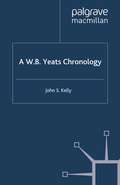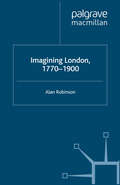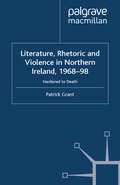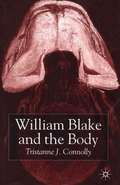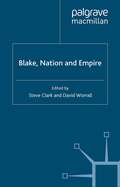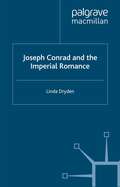- Table View
- List View
Hardy and His Readers
by T. WrightThis study examines Hardy's prolonged struggle with his contemporary readers, whose bourgeois values he despised. Initially content to compromise, to provide them with congenial entertainment, Hardy resorted at first to strategies of subversion, smuggling material past his editors and finally to outspoken attack. Professor T. R. Wright attempts to balance historical research into the response of 'actual' readers and the material conditions of publishing with literary-critical analysis of the 'implied' reader inscribed in the novels themselves.
The Classic Serial on Television and Radio
by Robert Giddings Keith SelbyThe classic serial, invented by BBC Radio Drama sixty years ago, survived and adapted itself to television, the arrival of colour and the global market in what has become a flood of classics with all channels competing for ratings and overseas sales. This richly detailed book traces these developments and analyses the genre's response to social, economic, technical and cultural changes, which have re-shaped it into the form we recognise today. The book contains considerable interview material with performers and media professionals.
Wallace Stevens: A Literary Life (Literary Lives)
by T. SharpeTony Sharpe explores the symbiotic and antagonistic relations between Stevens's literary life and his working life as insurance executive, outlining the personal, historical and publishing contexts that shaped his writing career, and suggesting how awareness of these contexts throws new light on the poems. In this appreciative but not uncritical study, Sharpe tries to see the man behind the mandarin, whilst remaining alert to the challengingly sumptuous austerities of one of America's most significant poets.
Dickens and Heredity: When Like Begets Like
by G. MorgentalerDespite the modern obsession with genetics and reproductive technology, very little has been written about Dickens's fascination with heredity, nor the impact that this fascination had on his novels . Dickens and Heredity is an attempt to rectify that omission by describing the hereditary theories that were current in Dickens's time and how these are reflected in his fiction. The book also argues that Dickens jettisoned his earlier belief in the prescriptive and deterministic potential of heredity after Darwin published The Origin of the Species in 1859.
Victorian Fiction: Writers, Publishers, Readers
by J. SutherlandDrawing on extensive research, John Sutherland builds up a fascinating picture of the cultural, social and commercial factors influencing the content and production of Victorian fiction, discussing major writers such as Collins, Dickens, Eliot, Thackeray and Trollope alongside writers also very popular with the reading public - Reade, Lytton and Mrs Humphry Ward - but whose fame has not endured. Richly informative on the Victorian literary and cultural scene, this new reissue of John Sutherland's important 1995 study is essential reading for all those interested in the evolution of the Victorian novel, and includes a new Preface situating the book in current research being carried out on the history of the book and print culture.
American Gangster Cinema: From "Little Caesar" to "Pulp Fiction" (Crime Files)
by F. MasonMuch analysis of gangster movies has been based upon a study of the gangster as a malign figuration of the American Dream, originally set in the era of the Depression. This text extends previous analysis of the genre by examining the evolution of gangster movies from the 1930s to the contemporary period and by placing them in the context of cultural and cinematic issues such as masculinity, consumerism and technology. With a close examination of many films from Scarface and Public Enemy to Reservoir Dogs and Pulp Fiction , this book provides a fascinating insight into a topical and popular subject.
Changing Ireland: Strategies in Contemporary Women's Fiction
by Christine St. PeterDuring the past twenty-five years, Ireland has seen an explosion of women's fiction - hundreds of published works that reimagine the inherited literary traditions and the social contexts of women's lives. Changing Ireland examines women's use of historical fiction, exile literature, Northern war narratives, speculative fiction, and classic 'realism', and looks at the local Irish forms of international women's genres like the romance novel and feminist fiction.
Japanese Writers and the West
by S. OkadaThis book concludes Sumie Okada's trilogy concerning cultural relationships between Japan and the West. This volume discusses six Japanese authors (Soseki, Mishima, Akiko Yosano, Hiroshi Yosano, Endo and Murakami), analysing the encounter between their traditional Japanese group-consciousness and western individualism. It also covers Endo's student days in Lyon, and his relationship with the humanist Françoise Pastre, appending a moving account by her sister Geneviève.
Romanticism and Male Fantasy in Byron’s Don Juan: A Marketable Vice (Romanticism in Perspective:Texts, Cultures, Histories)
by C. DonelanDon Juan , Byron's best poem, is a sensational radical satire. It uses the legend of Don Juan to expose the male fantasies behind Romanticism and nineteenth-century public culture. Critics feared that the poem was a 'manual for vice' and would corrupt society. Should England's best selling author have been censored? This book looks at how Europe's most famous literary celebrity shows his dark side in Don Juan , a canonical long poem and a pop culture masterpiece.
Trajectories of Mysticism in Theory and Literature (Cross Currents in Religion and Culture)
by P. LeonardTrajectories of Mysticism in Theory and Literature is a collection of essays which considers how recent critical theory contributes to debates about mystical and negative theology. This collection draws upon a wide range of material, including Biblical texts, autobiographical, confessional and fictional writing from the sixteenth century to the twentieth century, divinity in English, German, Spanish and French traditions, as well as work on God and metaphysics by Schelling, Weil, Levinas, Derrida, de Ma, Irigaray, and Cixous.
Designing Language Teaching Tasks
by K. JohnsonShort-listed for the British Council Innovation Awards 2004 that promote and reward excellence in English Language Teaching Designing Language Teaching Tasks provides a research-based account of how experienced teachers and task designers prepare activities for use in the language classroom. It gives detailed information on the procedures which designers follow. The book is a description of research and will therefore interest applied linguists and students in the field. It is written in a clear and comprehensible way, and should appeal to all those who want to learn to write good language teaching materials.
The Sensation Novel and the Victorian Family Magazine
by D. WynneVictorian sensation novels, with their compulsive plots of crime, transgression and mystery, were bestsellers. Deborah Wynne analyses the fascinating relationships between sensation novels and the magazines in which they were serialized. Drawing upon the work of Wilkie Collins, Mary Braddon, Charles Dickens, Ellen Wood, and Charles Reade, and such popular family journals as All The Year Round, The Cornhill, and Once a Week , the author highlights how novels and magazines worked together to engage in the major cultural and social debates of the period.
Postwar Academic Fiction: Satire, Ethics, Community
by K. WomackAs a literary genre, academic fiction has emerged in recent years as one of the most popular modes for satirizing the cultural conflicts and sociological nuances inherent in campus life. Drawing upon recent insights in ethical criticism and moral philosophy, Postwar Academic Fiction: Satire, Ethics, Community offers new readings of fictional and nonfictional works by such figures as Kingsley Amis, Vladimir Nabokov, Joyce Carol Oates, David Lodge, David Mamet, Ishmael Reed, Sandra M. Gilbert and Susan Gubar and Jane Smiley.
The Romantic Paradox: Love, Violence and the Uses of Romance, 1760-1830
by J. LabbeWhy are there so few 'happily ever afters' in the Romantic-period verse romance? Why do so many poets utilise the romance and its parts to such devastating effect? Why is gender so often the first victim? The Romantic Paradox investigates the prevalence of death in the poetic romances of the Della Cruscans, Coleridge, Keats, Mary Robinson, Felicia Hemans, Letitia Landon, and Byron, and posits that understanding the romance and its violent tendencies is vital to understanding Romanticism itself.
Coleridge, Schiller and Aesthetic Education
by M. KooyThis is the first book of its kind to consider at length Coleridge's relationship to his near contemporary, Friedrich Schiller. Contrary to received opinion, the author shows that Schiller's notion of 'aesthetic education' was indeed valuable to Coleridge at an early stage in his career and that it helped to shape much of his work - from his theory of imagination and his notion of the clerisy to his views on women and his account of historical change. Combining close readings with historical research, this book challenges readers to rethink the radical potential of idealist aesthetics.
Bloody Romanticism: Spectacular Violence and the Politics of Representation, 1776-1832 (Palgrave Studies in the Enlightenment, Romanticism and Cultures of Print)
by I. HaywoodThis book studies the impact of violence on the writing of the Romantic period. The focus is on the response of writers to a series of violent events including the revolutions in America and France and the Irish rebellion of 1798. Authors covered include Coleridge, Wordsworth, Scott, Byron, Fennimore Cooper, Equiano, and Helen Maria Williams.
An Elizabeth Gaskell Chronology (Author Chronologies Series)
by G. HandleyThis chronology will set Elizabeth Gaskell in her historical, social and literary contexts. It will focus on her career as a writer but will also underline her interactive roles as wife, mother, practical and tolerant Christian, radical sympathizer. Graham Handley discusses her early life, her marriage, the beginnings of her writing, the years of achievement, her social, humanitarian concerns, love of travel and its influence, with the balance of domesticity and creativity which is the key to her character.
Victorian Keats: Manliness, Sexuality and Desire
by J. NajarianThis book explores the sexual implications of reading Keats. Keats was lambasted by critics throughout the nineteenth century for his sensuousness and his 'effeminacy'. The Victorians simultaneously identified with, imitated, and distrusted the 'unmanly' poet. Writers, among them Alfred Lord Tennyson, Matthew Arnold, Gerard Manley Hopkins, John Addington Symonds, Walter Pater, and Wilfred Owen came to terms with Keats's work by creating out of the 'effeminate' poet a sexual and literary ally.
Raymond Williams’s Sociology of Culture: A Critical Reconstruction
by P. JonesThis detailed study of Williams unlocks his late sociology of culture. It covers previously overlooked aspects, such as his critique of Birmingham cultural studies, his use of an Adorno-like approach to 'cultural production', his 'social formalist' alternative to structuralism and post-structuralism and his approach to 'the media'.
A W.B. Yeats Chronology (Author Chronologies Series)
by J. KellyW.B.Yeats, one of the greatest poets who wrote in English, was also a playwright, theatre director, essayist, Senator, and life-long occultist. He knew practically every important figure in the cultural and public life of his time, including Oscar Wilde, Winston Churchill, James Joyce, Ezra Pound, and Eamon de Valera. In recording the details of these relationships and tracing his prolific literary output, this book is a vivid witness to an extraordinarily important, rich and crowded life, as a context for his work.
Imagining London, 1770-1900
by A. RobinsonCombining a unique overview of metropolitan visual culture with detailed textual analysis, this interdisciplinary study explores the relationship between the two cities which Londoners inhabited: the physical spaces of the metropolis, whose socially stratified and gendered topography was shaped by consumer culture and unregulated capitalism; and an imaginary 'London', an 'Unreal City' which reflected and influenced their understanding of, and actions in, the 'real' environment.
Rhetoric and Violence in Northern Ireland, 1968-98: Hardened to Death
by P. GrantDuring the Northern Irish Troubles of the past thirty years, a war of words has accompanied and interpenetrated with the actual conduct of violence in highly complex ways. This book considers how literature of the period engages and participates in this war of words. It draws on a range of contemporary authors and on a variety of printed sources, including journalists' reports, political speeches, interviews, memoirs, pamphlets and autobiography. The book places the Northern Ireland conflict within a broad European debate about the legitimate use of force, and provides an original analysis of the inter-relationship between language, literature and violence.
William Blake and the Body
by T. ConnollyWilliam Blake and the Body re-evaluates Blake's central image: the human form. In Blake's designs, transparent-skinned bodies passionately contort; in his verse, metamorphic bodies burst from each other in gory, gender-bending births. The culmination is an ideal body uniting form and freedom. Connolly explores romantic-era contexts like anatomical art, embryology, miscarriage and twentieth-century theorists like those of Kristeva, Douglas, Girard to provide an innovative new analysis of Blake's transformations of body and identity.
Blake, Nation and Empire
by D. Worrall S. ClarkThis book examines Blake's work in the context of discourses of nation and empire, of the construction of a public sphere, and restores the longevity to his artistic career by placing emphasis on his work in the 1820s. Relevant contexts include technology, sentimentalism, Ireland and Catholic Emancipation, missionary prospectuses and body politics.
Joseph Conrad and the Imperial Romance
by L. DrydenLinda Dryden places Almayer's Folly, An Outcast of the Islands , 'Karain', and Lord Jim in the context of the nineteenth-century imperial romance. Through the thwarted dreams and aspirations of his central characters she argues that Conrad exposes the empty promises of such fiction and challenges assumptions about the superiority of European imperialists and the imperial venture itself. Using illustrations from and references to many well-known novels of Empire, Dryden demonstrates how Conrad's Malay fiction alludes to the conventions and stereotypes of popular imperial fiction.
